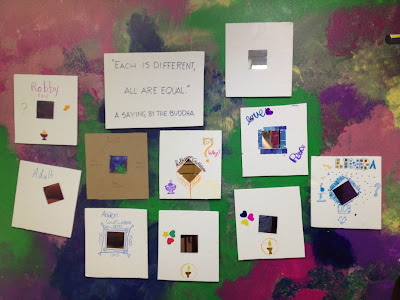The middle school youth group made "mirror boards". These will be added to throughout the year, creating reflections of who we are--those parts that can be seen by a mirror, and those which can't.
The youth also had a discussion about helping others, and ways we are each called to help.
The Discovery Class learned about some special rituals and celebrations in our church. They practiced with some objects we use--a bell chime, a song book, candles and stones for sharing joys and sorrows.
The Explorers class also learned about special celebrations in our church. We talked about how rites of passage are celebrated in our church to mark important milestones in people's lives.
Ways to extend the learning at home:
Look at the calendar in the church newsletter together and talk about any special events or celebrations that will be happening at our church.
If your child participated in a child dedication ceremony in our church, tell him or her about the dedication. (If you are interested in having your child dedicated in the church, contact Rev. James).
Talk about how there are things about people we can see and things we can't see. Look in a mirror together and describe who you see. Then make drawings or collages of the qualities you can't see about yourselves just by looking in the mirror. Talk about how everyone has aspects to themselves that we can't see just by looking at them.
Read the story Old Turtle together. Talk about how important it is to learn from one another. Unitarian Universalists believe that no one person has all the answers, and that we can all learn from each other.



















































